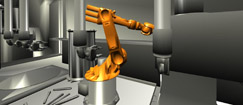Sunday 27 July 2014
Robotics and Autonomous Systems

Robotics and Autonomous Systems have been identified by the UK Government as one of the ‘Eight Great Technologies’ which have the potential to drive industrial strategy for economic growth. In 2012, the Technology Strategy Board created the Robotics and Autonomous Systems Special Interest Group (RAS-SIG). Its mission was to understand the nature of the landscape and the opportunity for RAS in the UK, to connect fragmented communities of researchers, industrialists and civil servants and to produce a national strategy to align efforts and inform future Government resourcing and organisation. NNL is helping to deliver this recently launched strategy.
Nuclear Robotics
The UK’s Nuclear Future Strategy has identified that a nuclear industry renaissance over the coming decades will see around £930 billion invested globally in new build fission reactors, an estimated global plant life extension (PLEX) worth £39.4 billion for the period of 2012-2020 alone.
Although nuclear energy is currently responsible for around 20% of the UK’s total supply, this figure is expected to rise to nearer 50% by 2030. In order to achieve the required 16GW of new nuclear power, £60 billion is being inveseted into a build of 12 new reactors at fiver sites across the UK. Hinkley Point, a £12 billion project to be constructed and operated by EDF Energy, will be the first nuclear power station built in the UK since 1995.
An inevitable byproduct of the rise of nuclear energy is the creation of a global decommissioning market, currently estimated to be worth £50 billion per annum by 2020. The total cost of nuclear decommissioning in the UK alone, mostly at Sellafield, is currently estimated at £60 billion. Analysis by the National Nuclear Laboratory indicates that 20% of the cost of complex decommissioning will be spent on RAS technology.
Owing to the high levels of radiation, all stages of the nuclear fission and fusion life cycle will require the use of advanced RAS tools and techniques. The need for innovation in this field turns the UK’s existing nuclear infrastructure into a highly significant asset, allowing for extensive on-site testing under real-world conditions to de-risk new technology and develop the essential safety cases. The UK is well placed to seize this market with its strength in national laboratories and the supply chain.
The various vaults, ponds and other facilities at Sellafield; research reactors at Winfrith; the JET and MAST fusion experiments at the UKAEA, Culham; and EDF’s reactor fleet, make us ideally placed to pioneer the next generation of tools and processes for nuclear remote operations. As the body of knowledge grows, the pace of safe, cost-efficient intervention will accelerate.
Knowledge and experience gained will be directly relevant to other challenging environments including submarine reactor systems and more widely in above ground infrastructure in the energy and construction sectors. Examples include petrochemical facilities, wind turbines and mining.
(This ‘Nuclear Robotics’ section is an excerpt from the RAS Strategy. You can view the full document by clicking on this link.)
